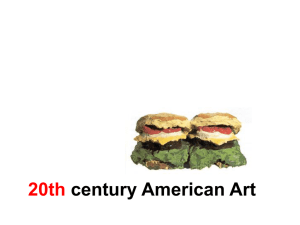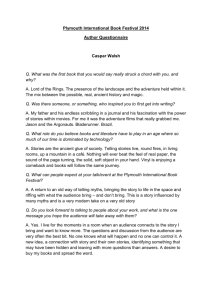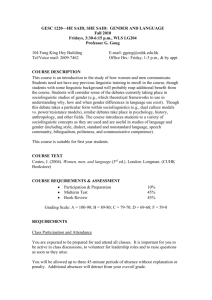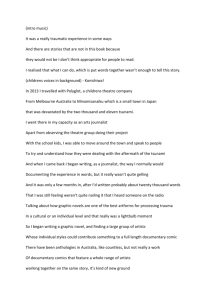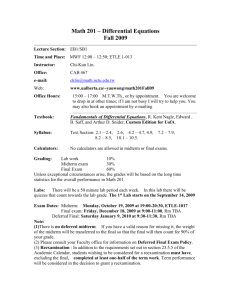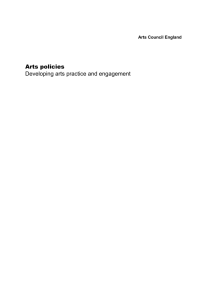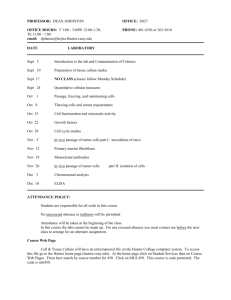Office: Classroom Bldg. 110B
advertisement
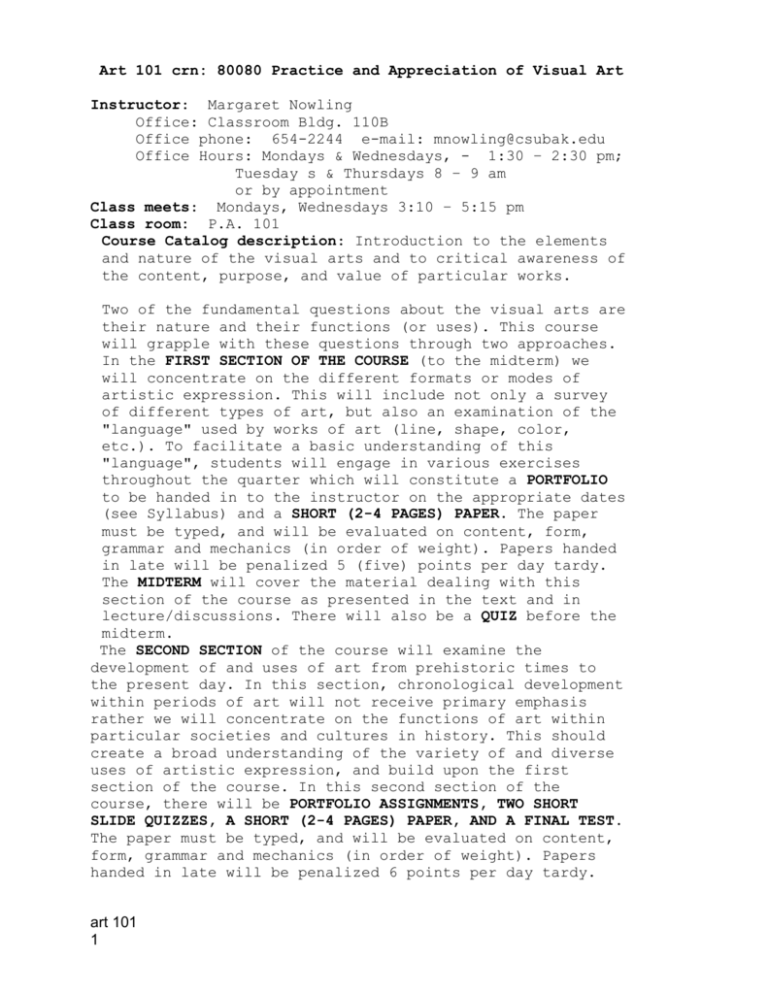
Art 101 crn: 80080 Practice and Appreciation of Visual Art Instructor: Margaret Nowling Office: Classroom Bldg. 110B Office phone: 654-2244 e-mail: mnowling@csubak.edu Office Hours: Mondays & Wednesdays, - 1:30 – 2:30 pm; Tuesday s & Thursdays 8 – 9 am or by appointment Class meets: Mondays, Wednesdays 3:10 – 5:15 pm Class room: P.A. 101 Course Catalog description: Introduction to the elements and nature of the visual arts and to critical awareness of the content, purpose, and value of particular works. Two of the fundamental questions about the visual arts are their nature and their functions (or uses). This course will grapple with these questions through two approaches. In the FIRST SECTION OF THE COURSE (to the midterm) we will concentrate on the different formats or modes of artistic expression. This will include not only a survey of different types of art, but also an examination of the "language" used by works of art (line, shape, color, etc.). To facilitate a basic understanding of this "language", students will engage in various exercises throughout the quarter which will constitute a PORTFOLIO to be handed in to the instructor on the appropriate dates (see Syllabus) and a SHORT (2-4 PAGES) PAPER. The paper must be typed, and will be evaluated on content, form, grammar and mechanics (in order of weight). Papers handed in late will be penalized 5 (five) points per day tardy. The MIDTERM will cover the material dealing with this section of the course as presented in the text and in lecture/discussions. There will also be a QUIZ before the midterm. The SECOND SECTION of the course will examine the development of and uses of art from prehistoric times to the present day. In this section, chronological development within periods of art will not receive primary emphasis rather we will concentrate on the functions of art within particular societies and cultures in history. This should create a broad understanding of the variety of and diverse uses of artistic expression, and build upon the first section of the course. In this second section of the course, there will be PORTFOLIO ASSIGNMENTS, TWO SHORT SLIDE QUIZZES, A SHORT (2-4 PAGES) PAPER, AND A FINAL TEST. The paper must be typed, and will be evaluated on content, form, grammar and mechanics (in order of weight). Papers handed in late will be penalized 6 points per day tardy. art 101 1 READING The basic text for the course is Peter Frank’s Preble's Artforms 9. THE ASSIGNED READINGS BENEATH EACH SCHEDULED CLASS MEETING IN THE SYLLABUS SHOULD BE READ BEFORE THAT MEETING in order to facilitate informed comprehension of the material covered in the class, and to allow classroom participation. GRADING Your final grade will be evaluated on the basis of your performance in the following: Portfolio: 30% Midterm Exam: 15% Quizzes: 15% Papers: 20% Final Exam: 20% PORTFOLIO ASSIGNMENTS There will be several artistic projects, which will be completed both in class and/or at home. Consequently, it is very important that you attend all class meetings. Portfolio will be turned in on March 2. Students will be graded on their efforts to complete the projects. Each complete portfolio will be worth 200 points, if it is turned in on the assigned date. Completed portfolios turned in after the due date will be worth 10 points less for every day they are late. TEST FORMATS *The first quiz will consist of 13 multiple choice questions worth 26 points. *The midterm will consist of 50 multiple-choice questions. *The second two quizzes will each consist of slide identification of works of art worth a total of 30 points. The slides should be identified as to period or culture, title, approximate date, and significance. *The final examination will deal with the second half of the course. It will consist of ten slide identifications worth 30 points, 20 multiple choice questions worth 40 points and an essay (worth 30 points). ***All slides illustrated on the quizzes and the final will be chosen from the illustrations in your textbook. PAPERS Topics for the papers will be handed out one week before they are due. The papers must be typed and double-spaced, and each should be two to four pages in length. Further art 101 2 information on the papers will be provided when the first topic is assigned. COURSE OBJECTIVES 1) Students will analyze an artistic composition in terms of its formal compositional qualities and its “language” of visual symbols. 2) Students will distinguish between different styles used in works of art. They will describe differences between such basic categories of art as representational, abstract and non-representational, as well the sub-categories such as naturalistic and expressionistic. 3) Students will describe the different media or materials and techniques used to produce works of art. 4) Students will develop an understanding of universal issues such as aesthetics, principles of visual communication, and why mankind makes art. 5) Students will compare and contrast the art of other times and cultures with art of 21st century United States. 6) Students will identify and discuss contemporary issues and problems in the visual arts through examination of recent art, most importantly to examine new forms of artistic presentation used by artists in order to express the dimensions of experience in relation to time, place, space and information. 7) Students will develop own artistic abilities in a variety of media. ***PLEASE NOTE: this syllabus will be changed at the instructor’s discretion.*** SYLLABUS Sept. 15: Introduction to the course. Class requirements. The uses of the visual arts. Visual Communication. Reading: Artforms pp. 2-40. Sept. 17: Visual elements. Principles of design. Reading: Artforms pp. 41-100. Sept. 22: Drawing. Reading: Artforms pp. 102-117. art 101 3 . Sept. 24: Painting and Printmaking. Review. Reading: Artforms pp. 118-145. Sept. 29: Quiz (1/2 hour). Photography, Film. First paper assignment. Reading: Artforms pp. 144-158. Oct. 1: Sculpture. Mixed Media works of art. Other threedimensional art media (crafts). Reading: Artforms pp. 181-210. Oct. 6: Design. Architecture. First paper due. Reading: Artforms pp. 211-230. Oct. 8: More architecture, etc. Review. Reading: Artforms pp. 211-230. Oct. 13: Midterm examination. Oct. 15: The arts in early cultures. The arts of Native Americans, and Africa. Reading: Artforms pp. 231-237; 327-348. Oct. 20: Non-Western Art: India, China, Japan. Reading: Artforms pp. 291-318. Oct. 22: The arts of ancient Mesopotamia, Egypt, Greece and Rome. Reading: Artforms pp. 237-253. Oct.27: The arts in the Middle Ages and Islam. Film: "A White Garment of Churches." Review. Reading: Artforms pp. 253-265, 319-326. Oct. 29: 2nd quiz (1/2 hour). Renaissance, Baroque, and Rococo art. Reading: Artforms pp. 266-289. Nov. 3: Neoclassical and Romantic art. Realism and Impressionism. Second Paper assignment. Reading: Artforms pp. 350-371. Nov. 5: Post-Impressionism. Modern art to 1914. Review. Reading: Artforms pp. 369-396. SOCI Nov. 10: Third Quiz (1/2 hour). Modern art between the World Wars. Papers due. Reading: Artforms pp. 399-421 Nov. 12: Modern Art from 1945 to 1970. Portfolios due Reading: Artforms pp. 422-450. Final Essay & Slide list. art 101 4 . Nov. 17: Postmodern Art: the art of our own age. Review. Reading: Artforms pp. 451-458, 460-485. Nov. 19: Nov. 24: The Final Examination is scheduled for REMEMBER TO BRING YOUR TYPED FINAL ESSAY, PENCIL, AND ERASER. art 101 5
